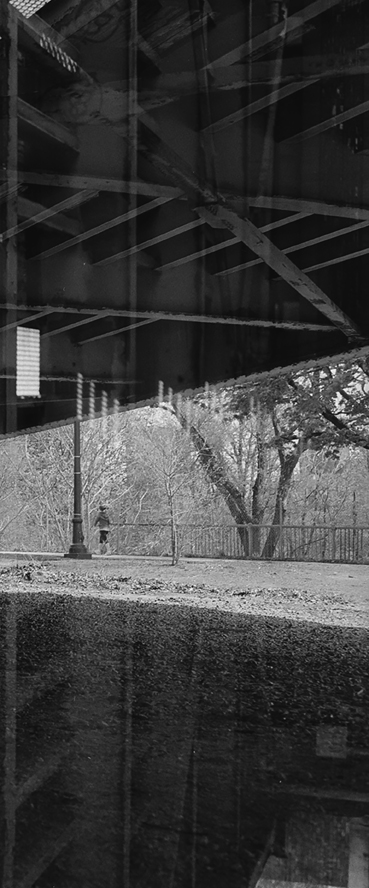

FIGURE 16.1 Untitled. © Steve Sikora
CHAPTER 16
Superstructure
SIKORA’S IMAGES ARE double exposures. There are various ways of achieving this effect: expose the same frame twice in the camera, double print two negatives, or blend two images with photo processing software. Sikora partially exposes his 4 × 5” view camera negatives and then walks and searches until he finds the next complementary exposure.
What Are We Looking at?
Two disparate views and experiences become one after he has made his second exposure. The latent information on the negative is amalgamated into a new single vision, the depiction of distinct spectacles, seen in two different places and recorded at two different times.
The proverbial looking glass is the opaque focusing screen of the 4 × 5” camera and we become witnesses to the frozen collision that is time, place, scale, and light. The ensuing chaos is both engrossing and tantalizing.
Where are we? When are we? How do we feel about being there? These may be some of the questions that you may ask yourself.
The where may be a glimpse of a recognizable or a known place, re-contextualized with another glimpse of somewhere else that is quite different.
The when may become a tempting investigation into what belongs to what and what came first. Ultimately though, this seems to be a zero-sum game as the vision in which we are already caught up in is something new. The when may be about the “now,” as we are looking, when you are seeing the image? So how do you feel about being there right now?
Does it appeal to you? Does it disorient you? Do you feel as if you are there or far from it?
There are many double- or multiple-exposure photographers who work with the technique in various ways to provide different experiences for their audience. Some are very simple and the constituent parts are easily distinguished. Some, like this image, are more complex and the experience is more disorienting. When we don’t dissect the frog but instead observe it, we will become immersed in what it does rather than in the sum of its parts. Likewise, our experience of the image becomes activated when we seek to explore this conflation of time and space instead of dissecting it for its parts. Since we read the image as the Latin alphabet dictates, we read from left to right. In so doing the left also becomes the past and the right becomes the future in our observation.
How Can the Image Be Interpreted?
The vista of nature that broadens towards the image’s right edge is the most intact and least convoluted part of the photograph. We see the little child seemingly lost in contemplation of nature and yielding to the authority of the fence that could easily be climbed. The lamp post becomes a stand-in for an adult and safety for its light, though that is purely symbolic since it is clearly daytime. The partially fallen leaves and child’s clothing suggests fall, it is getting colder and another year’s cycle is coming to a close to await winter’s sleep. The lamp also dissects this scene so that if we look at it more abstractly we can imagine two coupled railway cars driving out of the picture with no indication of how many cars have already passed and how many are yet to come. This too is a subtle reinforcement of the notion of cycles, of beginnings and endings.
All through this we can see the massive superstructure of our aging and crumbling urban infrastructure. The slight piercing by the scene just described is upstaged by what looks to be construction canvas, mimicking more train cars departing the image on a higher level and intersecting the trajectory of the previous train. All this is held together by the train station from hell, with its rotting roof to its decaying foundations, which we can magically see through the earth. Down in the bottom left there seems to be another platform and a footpath crossing under the X-beam. The multilevel, multidirectional maze gains an additional dynamic by the repetitious quad columns of light that penetrate all substantive matter in the image, and travel in receding directions all their own.
Conclusion
As in dreams, gravity, solid matter, and perspective are suspended for something else. It is in this something else, where the image finds me and I find it, that I am left with the recognition and certainty of everything I don’t yet know. The physiological illusion of depth, multidimensionality, and dislocation speaks not only of our age but also of bygone ages and those to come. The cycle is not just of the seasons, or of centuries, but of the time it appears to be taking for the gray matter in our brains to increase. For all the image’s chaos, information, and vibrancy, like an underused processor, it seems remarkably still, one could say, almost empty.
Assignments You May Want to Challenge Yourself With
• Double exposures
• Time and space
• Trains (of thought)
